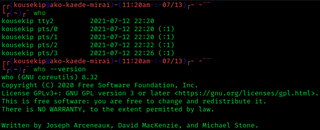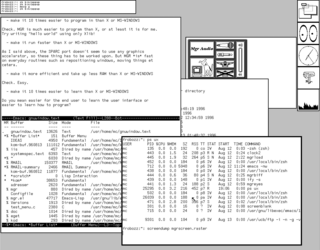
KornShell (ksh) is a Unix shell which was developed by David Korn at Bell Labs in the early 1980s and announced at USENIX on July 14, 1983. The initial development was based on Bourne shell source code. Other early contributors were Bell Labs developers Mike Veach and Pat Sullivan, who wrote the Emacs and vi-style line editing modes' code, respectively. KornShell is backward-compatible with the Bourne shell and includes many features of the C shell, inspired by the requests of Bell Labs users.

Plan 9 from Bell Labs is a distributed operating system which originated from the Computing Science Research Center (CSRC) at Bell Labs in the mid-1980s and built on UNIX concepts first developed there in the late 1960s. Since 2000, Plan 9 has been free and open-source. The final official release was in early 2015.

A Unix shell is a command-line interpreter or shell that provides a command line user interface for Unix-like operating systems. The shell is both an interactive command language and a scripting language, and is used by the operating system to control the execution of the system using shell scripts.

The X Window System is a windowing system for bitmap displays, common on Unix-like operating systems.

Xenix is a discontinued version of the Unix operating system for various microcomputer platforms, licensed by Microsoft from AT&T Corporation in the late 1970s. The Santa Cruz Operation (SCO) later acquired exclusive rights to the software, and eventually replaced it with SCO UNIX.
The C programming language provides many standard library functions for file input and output. These functions make up the bulk of the C standard library header <stdio.h>. The functionality descends from a "portable I/O package" written by Mike Lesk at Bell Labs in the early 1970s, and officially became part of the Unix operating system in Version 7.

USENIX is an American 501(c)(3) nonprofit membership organization based in Berkeley, California and founded in 1975 that supports advanced computing systems, operating system (OS), and computer networking research. It organizes several conferences in these fields.
An environment variable is a user-definable value that can affect the way running processes will behave on a computer. Environment variables are part of the environment in which a process runs. For example, a running process can query the value of the TEMP environment variable to discover a suitable location to store temporary files, or the HOME or USERPROFILE variable to find the directory structure owned by the user running the process.

Matthew Dillon is an American software engineer known for Amiga software, contributions to FreeBSD and for starting and leading the DragonFly BSD project since 2003.
The V operating system is a discontinued microkernel distributed operating system that was developed by faculty and students in the Distributed Systems Group at Stanford University from 1981 to 1988, led by Professors David Cheriton and Keith A. Lantz. V was the successor to the Thoth operating system and Verex kernel that Cheriton had developed in the 1970s. Despite similar names and close development dates, it is unrelated to UNIX System V.

The Unix wars were struggles between vendors to set a standard for the Unix operating system in the late 1980s and early 1990s.
The Berkeley r-commands are a suite of computer programs designed to enable users of one Unix system to log in or issue commands to another Unix computer via TCP/IP computer network. The r-commands were developed in 1982 by the Computer Systems Research Group at the University of California, Berkeley, based on an early implementation of TCP/IP.

In some operating systems, including Unix and Linux, a pseudoterminal, pseudotty, or PTY is a pair of pseudo-device endpoints (files) which establish asynchronous, bidirectional communication (IPC) channel between two or more processes. The master provides means by which a terminal emulator process controls the slave. The slave emulates a hardware text terminal device. PTY are similar to bidirectional pipes.

The standard Unix command who displays a list of users who are currently logged into the computer.

ManaGeR or MGR is an early windowing system originally designed and developed for Sun 2/120 workstations in 1984 by Stephen A. Uhler, then at Bellcore.

In computer software, logname is a program in Unix and Unix-like operating systems that prints the name of the user who is currently logged in on the terminal. It usually corresponds to the LOGNAME variable in the system-state environment.

Terminfo is a library and database that enables programs to use display terminals in a device-independent manner. Mary Ann Horton implemented the first terminfo library in 1981–1982 as an improvement over termcap. The improvements include
UNIX Review was an American magazine covering technical aspects of the UNIX operating system and C programming. Recognized for its in-depth technical analysis, the journal also reported on industry confabs and included some lighter fare.

The Software Tools Users Group (STUG) was a technical organization started in 1976, in parallel with Usenix. The STUG goal was to develop a powerful and portable Unix-like system that could be implemented on top of virtually any operating system, providing the capabilities and features of Unix in a non-proprietary system. With its focus on building clean, portable, reusable code shared amongst multiple applications and runnable on any operating system, the Software Tools movement reestablished the tradition of open source and the concepts of empowering users to define, develop, control, and freely distribute their computing environment.

Human Computing Resources Corporation, later HCR Corporation, was a Canadian software company that worked on the Unix operating system and system software and business applications for it. Founded in 1976, it was based in Toronto.














